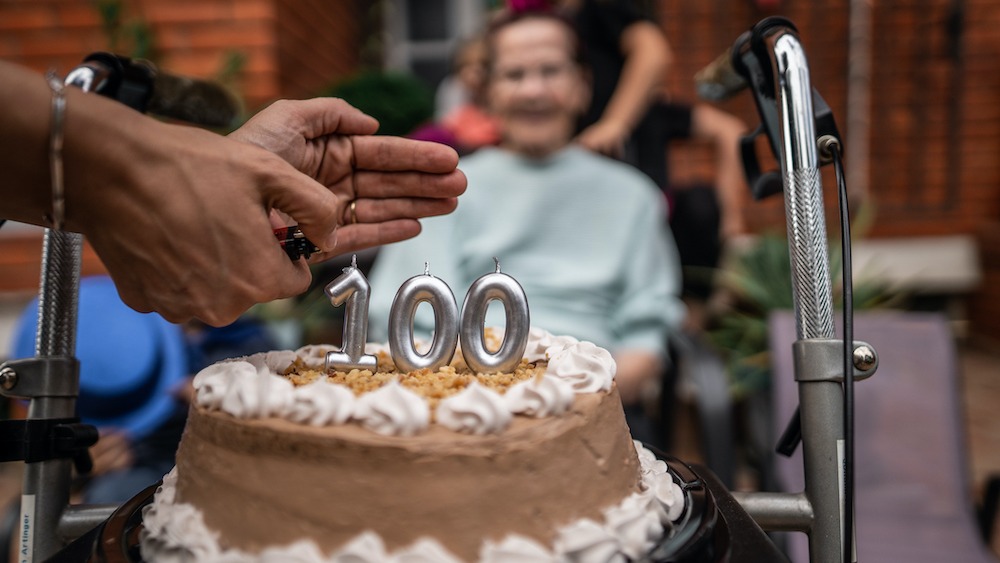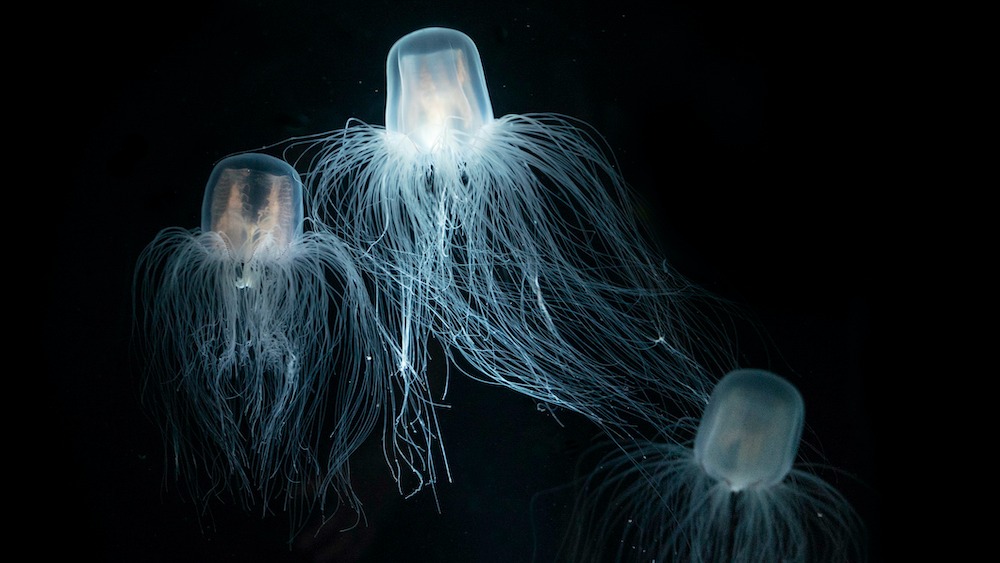Extreme longevity: The secret to living longer may be hiding with nuns... and jellyfish
Some people live to be well beyond 100. But what genes and environmental factors contribute to such extreme longevity, and what can we learn from other long-lived animals?

On March 4, María Branyas Morera turned 116. In January, the great-grandmother, who was born in San Francisco in 1907 and now lives in a nursing home in Catalonia, Spain, became the world's oldest person following the death of Sister André (née Lucile Randon), a French nun who lived to be 118.
Branyas Morera, who goes by the nickname "super grandmother," has lived through the 1918 Spanish flu pandemic, both World Wars and the Spanish Civil War. She also survived a bout of COVID-19 just weeks after turning 113, according to Guinness World Records.
Branyas Morera attributes her long life to a number of things, from enjoying nature and good company to "staying away from toxic people," but she ultimately credits her extreme longevity to "luck and good genetics," she told Guinness World Records.
Branyas Morera is part of a super-exclusive club: She is a supercentenarian, meaning a person who is 110 years or older. For instance, in Japan only about 30 people can claim this title, meaning only 1 in 871,600 people reaches this milestone, according to the New England Centenarian Study. In comparison, approximately 573,400 centenarians (people who are at least 100 years old) were alive worldwide in 2021, according to the United Nations.
Related: We're nowhere near reaching the maximum human life span, controversial study suggests
People like Branyas Morera could help scientists better understand what allows some people to live so long. Is their longevity just luck, or is it due to good genes and other factors? And which genes are the most critical to defying the aging process?
Studying centenarians and supercentenarians also could reveal insight into the maximum life span for humans — and potentially ways to extend it. Supercentenarians tend to have certain lifestyle factors in common, which may help people overall lead longer, healthier lives. But to dramatically extend the human life span, scientists may have to venture beyond Homo sapiens and look to our long-lived animal counterparts.
Get the world’s most fascinating discoveries delivered straight to your inbox.

Are good genes the key to extreme longevity?
Genes clearly play a role in longevity. Children and siblings of centenarians tend to live longer than average, according to Medline, a service of the National Library of Medicine. And a 2016 study in the journal Aging found that genes tied to immune function and cell repair were more active in these extremely old people.
In general, scientists estimate that about 25% of life span is determined by genetics. But which specific genes, if any, play the largest roles in aging?
For decades, Dr. Annibale Puca, a professor of genetics at the University of Salerno in Italy, has been trying to answer that question.
In 2011, Puca discovered a human gene called BPIFB4 that halts cardiovascular aging and even reverses some aspects of aging when inserted into mice. In a 2015 paper in the journal Circulation Research, Puca and his colleagues showed that a certain version of BPIFB4 was associated with exceptional longevity and was overrepresented in centenarians. Those with two copies of the gene variant had less cardiovascular illness, lower blood pressure and less arteriosclerosis, compared with people without two copies of the gene variant. Puca estimates that about 10% of humans have this gene variant.
Could BPIFB4 partly explain why certain people are predisposed to living longer than others? Puca thinks so. "You don't live to 110 unless you have good genes," he told Live Science.
In follow-up research, Puca's team not only halted heart damage in middle-age and elderly mice but also reversed the biological age of the mice's hearts by the human equivalent of 10 years, according to the study.
"In the lab, we were able to regenerate their blood vessels and vascular (circulatory) systems, which converted inflammatory cells into anti-inflammatory cells," Puca said. "We found that cardiovascular function was corrected in the mice."
In a paper published Jan. 13 in the journal Cardiovascular Research, Puca and his team introduced the gene into heart cells collected from organ donors who had died of heart failure. As with the lab mice, the mutated gene rewound the clock and reversed cardiac aging by increasing cardiovascular function by 20% to 60%. Inflammatory cells also morphed into healthy cells.
"We now know that it works in human tissue," Puca said.
Related: Human life span may have an 'absolute limit' of 150 years
Puca's colleague Paolo Madeddu, a professor of experimental cardiovascular medicine at the University of Bristol in England, said that if more research backs up the effect, BPIFB4 could be inserted via gene therapy into the cells of people who don't carry the gene. However, the application of this treatment is still many years away.
"You would need to repeat the therapy over and over again," Madeddu told Live Science. "It doesn't last forever."
The researchers are currently testing whether the protein the gene codes for, rather than the anti-aging gene itself, can have similar effects in cardiac cells.
BPIFB4 isn't the only gene tied to a longer life span. In 2019, researchers described a so-called "longevity gene," Sirtuin 6 (SIRT6), in the journal Cell. SIRT6 helps repair DNA, which aging cells can't repair efficiently, leading to gene mutations that can drive cancer and other illnesses.
The researchers analyzed the activity of SIRT6 in a range of rodent species, from mice to beavers, and found that the animals with the longest life spans also had the most efficient DNA repair capabilities due to their SIRT6 proteins being "more potent," according to the study.
Last year, a follow-up study in The Embo Journal looked at a cohort of 450 Ashkenazi Jewish centenarians and 550 Ashkenazi Jewish individuals who didn't have a family history of extreme longevity. The researchers discovered that a "novel rare variant," which they dubbed "centSIRT6," was twice as prevalent in the centenarians than in the latter group.
In lab dishes, they also found that centSIRT6 not only helped repair broken DNA but also "more robustly kill[ed] cancer cells" when compared with the more common version of SIRT6, according to the study.
Environmental factors tied to extreme longevity

While variations in human genes affect longevity, environmental factors also play a role. Numerous studies have shown that things like being optimistic, having a healthy diet and not smoking are tied to living a longer life.
But can supercentenarians tell us about other factors that may extend life span? Some researchers say they've uncovered hints in a surprising place: convents.
Before Branyas Morera held the title of the world's oldest person, a French nun, Sister André, was the oldest living person. That may not be a coincidence. Many Catholic nuns live to become centenarians — and even supercentenarians. But why is this?
Several years ago, anthropologist Anna Corwin, author of "Embracing Age: How Catholic Nuns Became Models of Living Well" (Rutgers University Press, 2021), spent time at a convent in the Midwest, interviewing the nuns who lived there. Corwin noticed similar patterns in the women's lives that may be tied to longevity.
"It's not specifically because they're nuns that they're able to live for so long, but rather the types of cultural practices they engaged in," Corwin, an associate professor of women's spirituality and anthropology at the California Institute of Integral Studies in San Francisco, told Live Science.
In general, nuns were living lives full of meaning. It also helped that they were part of a tight-knit, supportive community.
Related: People who live to be 100 have unique gut bacteria signatures
The nuns also tended to reject the stigma around aging. Corwin said they participated in day-to-day activities, such as prayer and socializing, well into old age. And they didn't necessarily view themselves as elderly.
"One of my first months at the convent, I met this 95-year-old woman who was in a wheelchair totally hunched over, who you would imagine couldn't participate in anything," Corwin said. "I asked her what she does with her days, and she said, 'I serve the infirm and visit the elderly.' Sure enough, as I watched her, she would wheel slowly down the hallway and check in on her neighbors in the infirmary to make sure they were doing well."
Corwin concluded that the nun found fulfillment and meaning in life by helping others. She also viewed herself as having autonomy and agency, Corwin said.
While this evidence may be anecdotal, a study conducted by epidemiologist and leading Alzheimer's expert David Snowdon backed up these observations. In 2003, Snowdon conducted a longitudinal study of 678 nuns from the School Sisters of Notre Dame, an international organization recognized by the Catholic Church.
Snowdon found that nuns had "lower all-cause mortality rates than did the general population and this mortality advantage increased over time." In fact, these nuns were "27% more likely to live into their 70s than their lay peers, and their likelihood of living longer increased with time," Corwin wrote in her book. In addition, the nuns were less likely to smoke, and they ate healthily and lived peaceful and communal lives.
It's not clear how some of the most obvious differences between nuns and the general population — namely, that they make vows of celibacy and don't have children — affect longevity. Some research has found that each child a woman gives birth to shaved off years of a woman's life, while other studies have shown that people with children live longer than the child-free.
What animals reveal about extreme longevity

While human genes and environmental influences may lead to incremental improvements in longevity, to make leaps and bounds, it may help to look to the animal kingdom.
That's what Steven Austad, a distinguished professor in the department of biology at The University of Alabama at Birmingham, is doing.
Last year, Austad, who is also senior scientific director interim chair with the American Federation for Aging Research, wrote a book titled "Methuselah's Zoo: What Nature Can Teach Us about Living Longer, Healthier Lives" (MIT Press, 2022). (The title is a nod to Methuselah, a biblical patriarch who supposedly lived to be 969 years old.) Austad's book focuses on the longest-living animals on Earth, from bowhead whales (Balaena mysticetus), which can live 200-plus years, to Escarpia laminata, a species of tube worm found in the Gulf of Mexico that has an average life span of about 300 years.
However, the creature that captured Austad's attention was the world's oldest animal, a 507-year-old ocean quahog (Arctica islandica) dubbed "Ming the Mollusk."
One factor in Ming's longevity is clearly its underwater environment: It's "cold, safe and deficient of any real predators," Austad wrote in 2022 in an article for The Atlantic.
"Mollusks like Ming spend most of their lives living in really cold water burrowed in the mud and covered by a thick shell," Austad told Live Science. "Living at the bottom of the ocean is very stable, and being in the mud probably adds a layer of safety as well as having a shell."
Austad suspects that when animals aren't prone to predation or to the vagaries of a harsh or chaotic environment, evolution favors physiology that lasts a long time.
Bivalves also draw heat from their surroundings rather than generating it themselves the way humans and other mammals do. This may lead to creatures like Ming that are better protected from oxidative stress, Austad hypothesized. (Oxidative stress, or damage to tissue by chemically reactive oxygen compounds, has long been linked to aging.)
To test his theory, Austad and his students brought a variety of mollusk species into their lab, including bay scallops (Argopecten irradians), which live an average of two years; table clams, which can live up to a century; and a handful of super-aging ocean quahogs like Ming, and introduced oxygen-radical generating chemicals to their tanks. The scallops succumbed within two days, while the table clams held on for 11.
Two weeks into the experiment, the quahogs remained "happy as a clam" despite living in tainted water, Austad said. This suggested that the quahogs were recovering from or preventing oxidative stress.
"As humans, we can't replicate their living conditions, but we can figure out how they do it," Austad said. "[There are] no doubt some genetic tricks, but it could also be something that we could replicate pharmacologically if we understood it well enough."
Currently, there's only one animal species that could theoretically live forever: the immortal jellyfish (Turritopsis dohrnii). No bigger than a pinky nail, these translucent blobs can turn back their biological clocks when injured and revert into plant-like polyps sprouting from the ocean floor. If enough of these polyps colonize, they can eventually begin to bud and "release medusae that are genetically identical to the injured adult," according to the American Museum of Natural History.
This shape-shifting is possible thanks to a process known as transdifferentiation, which restarts cell generation and essentially gives these amorphous blobs a second lease on life. For the past three decades, scientists have been studying this mechanism and different ways to apply it to humans.
So far, no one has pinpointed the reason cells can transdifferentiate. But a 2022 paper published in the journal Proceedings of the National Academy of Sciences found that T. dohrnii had double the DNA repair genes of other jellyfish species. They also had gene mutations that protect telomeres, the caps on the ends of chromosomes, which typically shorten with age, according to the study.
However, that doesn't mean humankind could borrow these genes and seemingly live forever — or become supercentenarians like Branyas Morera, for that matter. Only time will tell.
Editor's Note: This story was corrected on Friday, March 31 at 9:45 a.m. EDT to note that there are only 30 supercententarians alive today in Japan, not worldwide. It was also corrected to note that the U.N. data on the the total number of centenarians alive worldwide was from 2021.
Due to an editing error, the article also mistakenly said that Snowdon's research compared the health outcomes of nuns with different lifestyles; his research only compared the health outcomes of nuns with the general population, not with each other. That reference was removed on April 4.
Jennifer Nalewicki is former Live Science staff writer and Salt Lake City-based journalist whose work has been featured in The New York Times, Smithsonian Magazine, Scientific American, Popular Mechanics and more. She covers several science topics from planet Earth to paleontology and archaeology to health and culture. Prior to freelancing, Jennifer held an Editor role at Time Inc. Jennifer has a bachelor's degree in Journalism from The University of Texas at Austin.


